
Hypselodoris picta
(Schultz, 1836)
Order: NUDIBRANCHIA
Suborder: DORIDINA
Superfamily: EUDORIDOIDEA
Family: Chromodorididae
DISTRIBUTION
Atlantic - west atlantic from Florida to Brazil, Caribbean; east Atlantic from Spain to West Africa, Mediterranean.
PHOTO
RIGHT: ek076703: Italy, Elba Is., Capoliveri, divesite "Stella" size 3 cm, depth 28 m , July 12, 1997; ek075601: Italy, Elba Is., Capoliveri, divesite "Fonza" size 5 cm, depth 5 m , July 06, 1997; ek109227: Spain, Cala Joncols, divesite "La Virgen" size 45 mm, depth 13 m , April 27, 2000. Photos: Erwin Koehler.
LOWER RIGHT: (marco01) France, Antibes, divesite "Cap d'Antibes" size unrecorded, depth 14 m, July 1998, Photo: Armand di Marco, e-mail: armand.dimarco@ci.educ.lu
LOWER LEFT: (ek086520): Spain, Cala Joncols, divesite "El Bisbal" size 6 cm, depth 14 m , May 01, 1998. Photo: Erwin Koehler.
Hypselodoris picta is the largest chromodorid from the Mediterranean Sea and is widely distributed on both sides of the Atlantic. It varies greatly in colour and pattern and consequently has been known under many names including
Hypselodoris elegans (Cantraine, 1835)
Hypselodoris webbi (d'Orbigny, 1839)
Hypselodoris valenciennesi (Cantraine, 1841)
Hypselodoris edenticulata (White, 1952)
Hypselodoris tema Edmunds, 1981.
Ortea, Valdés and García-Gómez (1996) have recently revised this group of chromodorids and have suggested five subspecies, and Troncoso, Garcia & Urgorri (1998) have suggested six, but there do seem to be a number of colour forms which do not fit into their subspecies very successfully. At least two 'subspecies', picta and webbi have wide sympatric distributions on either side of the tropical Atlantic which is not what one would expect from subspecies:
Hypselodoris picta picta (Schultz, 1836)
Hypselodoris picta webbi (d'Orbigny, 1839)
Hypselodoris picta azorica Ortea, Valdes & Garcia-Gomez, 1996
Hypselodoris picta tema Edmunds, 1981.
Hypselodoris picta verdensis Ortea, Valdes & Garcia-Gomez, 1996
Hypselodoris picta lajensis Troncoso, Garcia & Urgorri (1998)
Hypselodoris picta is the only eastern Atlantic species of Hypselodoris, other than Hypselodoris villafranca, with more than two parallel yellow lines on the dorsum. Juvenile specimens have normally three lines, whereas in the adults the pattern is more complicated with numerous broken or entire lines. It is also characteristic of this species that two of the dorsal lines reach the rhinophoral sheaths. In adult specimens they form a yellow circle around the edge of the rhinophoral sheath and continue forward. In juvenile specimens, like this in the picture, the yellow circles are not formed yet. In addition, juvenile specimens have the mantle margin is surrounded by a white area. The dorsal yellow lines of both juveniles and adults reach the gill sheath but they never form a circle around it. Other distinctive features of H. picta are the uniformly dark blue rhinophores, with no yellow or white pigment, and the branchial leaves with the external rachis yellow." ...Angel Valdes. [See message below].
Ortea et al (1996) note previous observations of it feeding on the sponge Dysidea fragilis in the Mediterranean.
References:
• Ortea, J., Valdés, A. & and García-Gómez, J.C. (1996) Revisión de las especies atlánticas de la familia Chromodorididae (Mollusca: Nudibranchia) de grupo cromático azul. [Review of the Atlantic species of the family Chromodorididae (Mollusca: Nudibranchia) of the blue chromatic group.] Avicennia, 1996, Suppl. 1: 1-165.
• Troncoso, J.S., Garcia, F.J. & Urgorri, V.,(1998) Anatomical data on rare Hypselodoris picta (Schultz, 1836) (Gastropoda, Doridacea) from the coast of Brazil with description of a new subspecies. Bulletin of Marine Science, 63(1): 133-141.
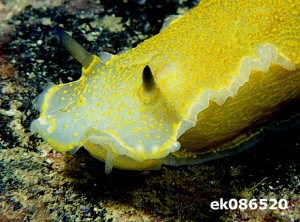
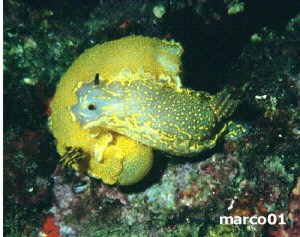
Rudman, W.B., 2000 (June 1) Hypselodoris picta (Schultz, 1836). [In] Sea Slug Forum. Australian Museum, Sydney. Available from http://www.seaslugforum.net/find/hypspict
Related messages
Re: Florida nudibranch
June 5, 2009
From: Terri Johnson
Concerning message #22519:
Thanks so much for the response... it's nice to know, officially, what the animals are, especially filling out a dive log on the specimans we saw.
Cordially,
Terri Johnson
etj95@suddenlink.net
Johnson, T., 2009 (Jun 5) Re: Florida nudibranch. [Message in] Sea Slug Forum. Australian Museum, Sydney. Available from http://www.seaslugforum.net/find/22525Re: Florida nudibranch
June 4, 2009
From: Terri Johnson
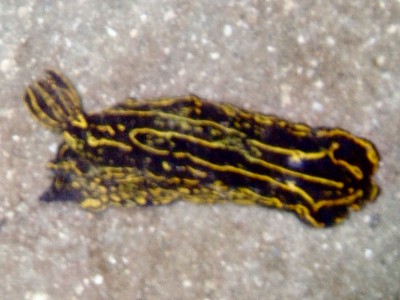
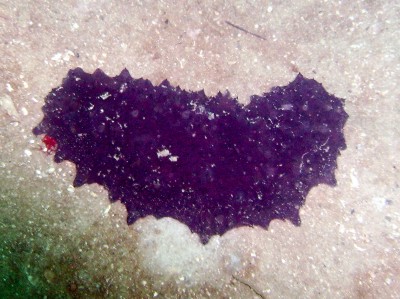
Concerning message #2446:
I was searching for various types of nudibranchs and found this forum... I recently photographed some on a dive site off the gulf in Florida. Hope these help. I think the bluish-black w/yellow markings is perhaps the one you guys are discussing; the other two I have no idea. Would appreciate any light you could shed on them.
Locality: Destin, 90 feet, Florida, USA, gulf coast, 19 May 2009, sandbed. Length: approx. 5-6 inches. Photographer: Terri Johnson.
Thanks!
Terri Johnson
etj95@suddenlink.net
Johnson, T., 2009 (Jun 4) Re: Florida nudibranch. [Message in] Sea Slug Forum. Australian Museum, Sydney. Available from http://www.seaslugforum.net/find/22519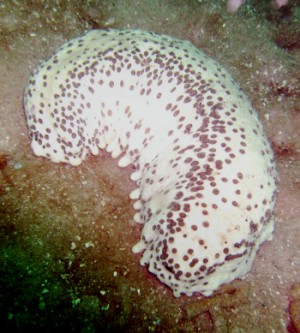
Dear Terri,
The blue and yellow animal is the nudibranch Hypselodoris picta which is found on both sides of the Atlantic. It has also been called Hypselodoris edenticulata in the Caribbean. Your other two photos are of animals which although called 'seaslugs' by some people are not true slugs at all. They are holothurians [= sea cucumbers, beche de mer etc], close relatives of starfish and sea urchins.
Best wishes,
Bill Rudman
Feeding Hypselodoris picta in an aquarium
August 26, 2008
From: Steven Soskin
Hi,
We were diving in Miami Florida today and saw a beautiful Florida Regal Goddess nudibranch [Hypselodoris picta], probably 6-7cm. My friend took it and put it in a bag and I asked him to put it back since it'd probably die in his tank. I see they actually sell them online so I guess they're not so rare.
What do they eat, and is it possible to keep them alive for a while in a reef tank?
Locality: Miami beach, 47 , Florida, USA, atlantic, 18 May 2008, Length: 7cm
thanks
Steven
soskin@yahoo.com
Soskin, S., 2008 (Aug 26) Feeding Hypselodoris picta in an aquarium. [Message in] Sea Slug Forum. Australian Museum, Sydney. Available from http://www.seaslugforum.net/find/21585Dear Steven,
You were right to ask your friend to put the nudibranch back. I am pretty sure it feeds on the sponge Dysidea etheria [see #13023 ] but even if you could collect some of the sponge, it is very difficult to remove it from the sea and keep it alive in an aquarium - even under the best conditions. And when you think that what you would need to do is to keep it alive and healthy in an aquarium while it was being eating alive by a nudibranch, I hope you realise that is just not a practical proposition.
Chromodorids, such as Hypselodoris picta are very beautiful, but I think it is better to take a photo than take an animal which is destined to die in captivity.
Best wishes,
Bill Rudman
Hypselodoris picta from Antibes, France
August 22, 2008
From: Dominique Horst
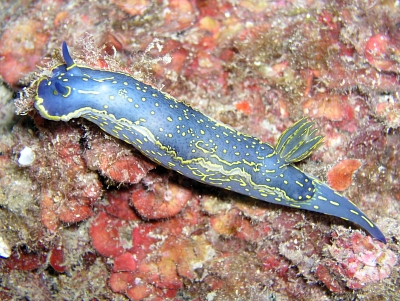
Hi Bill,
This is to share a picture taken by a friend of Hypselodoris picta.
I've never seen this colour form before...
Locality: Antibes, 20 m, France, Mediterranean sea, 12 July 2002. Length: 8 cm. Photographer: Elisabeth Juan.
Kind regards,
Dom.
dominique.horst@wanadoo.fr
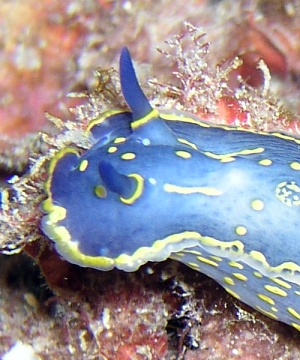
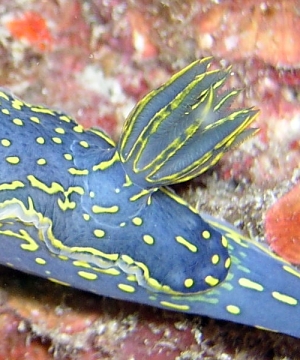
Thanks Dom,
Bill Rudman
Hypselodoris picta from Greece
February 29, 2008
From: Hans van Rijn
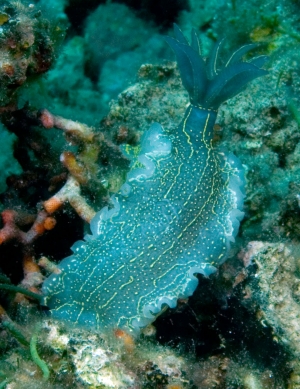
Possibly a dorid species?
Locality: Nisis Oxia, Gulf of Patras, 6 m, Greece, Mediterranean, 23 July 2007, rocky bay. Length: 40 mm. Photographer: Hans van Rijn.
Hans van Rijn
hvrijn@orange.nl
Rijn, H. van, 2008 (Feb 29) Hypselodoris picta from Greece. [Message in] Sea Slug Forum. Australian Museum, Sydney. Available from http://www.seaslugforum.net/find/21194Dear Hans,
Definitely a dorid, and more specifically a chromodorid. This is Hypselodoris picta, which as you will see from the Fact Sheet, is quite variable in colour and is considered to consist of a group of subspecies found on both sides of the warm water Atlantic (and Mediterranean).
Best wishes,
Bill Rudman
Seaslug from Greece
October 9, 2007
From: Chris Heerema
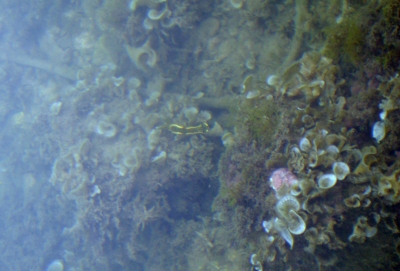
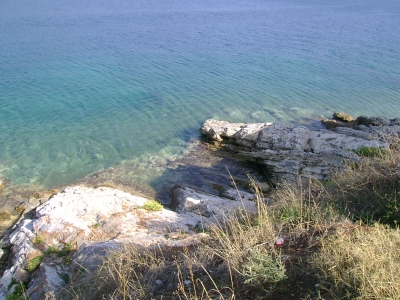
Hi,
Last week I was on holiday with my family to the Greek island of Keffalonia. One day we went to a small village (Fiskardo) on the northern tip of the island. When we were walking across the shore line, I spotted this seaslug in the water. My little brother was eager to pick it up but I told him not to, knowing some of these slugs are poisonous. We did took a picture of it, and now I'm rather curious what species it is? It's in the centre of the picture I added, it is overall black, with some yellow spots/stripes running across it's back and it has a yellow edge.
Locality: Kefalonia, Fiskardo, ~0.5 metres, Greece, mediterranean, Ionian Sea, 29th of September 2007. Length: ~15 cm? (unsure about this one). Photographer: Chris Heerema
I would appreciate it if you could help me identify this creature.
Greetings,
Chris Heerema
chrisheerema49@hotmail.com
Heerema, C., 2007 (Oct 9) Seaslug from Greece. [Message in] Sea Slug Forum. Australian Museum, Sydney. Available from http://www.seaslugforum.net/find/20907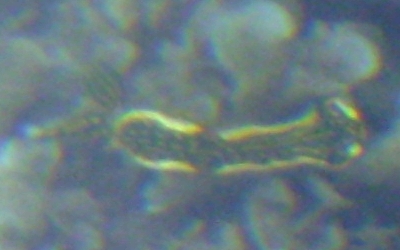
Dear Chris,
This is Hypselodoris picta. If you look at the species Fact Sheet and the messages attached to it you will see that this species is quite variable in colour and is found on both sides of the Atlantic. Although many nudibranchs have glands in their skin in which they store poisonous chemicals, they are there to protect the animal from being eaten, so while I wouldn't put one in my mouth, they are ok to pick up and look at unless you have very sensitive skin.
Best wishes,
Bill Rudman
Hyspelodoris picta from Lanzarote, Canary Islands
August 18, 2007
From: Mascha van Delft
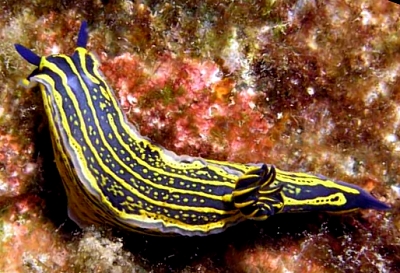
Hello
In May we were diving in Lanzarote, Canary Islands and we found this slug. I can´t find out what the name of this one is. Can you help me out?
Locality: Puerto del Carmen, 15 m, Lanzarote, Canary Islands, [Spain]Atlantic Ocean, 20 may 2007. Photographer: Dave van Delft.
Mascha van Delft
mascha_trompet@hotmail.com
van Delft, 2007 (Aug 18) Hyspelodoris picta from Lanzarote, Canary Islands. [Message in] Sea Slug Forum. Australian Museum, Sydney. Available from http://www.seaslugforum.net/find/20485Dear Mascha,
This would appear to be the common colour form of Hypselodoris picta found in the Canary Islands. It is sometimes considered to be the subspecies H. picta webbi, but as I discussed recently [#20361], I find the use of the concept of subspecies for this group of animals rather puzzling.
Best wishes,
Bill Rudman
Mating Hypselodoris picta from Canary Ids
August 4, 2007
From: Brian Mayes
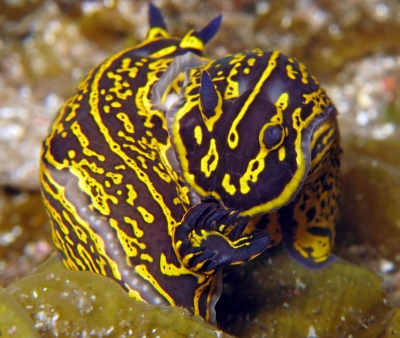
Dear Bill,
I found two pairs of mating Hypselodoris picta webbi on a recent dive off the island of El Hierro in the Canary Islands. The pairs were only a few inches apart. It was difficult to see exactly what was going on with each pair but I managed to snap a few photos that I hope you will find interesting.
Locality: "El Rincón", La Restinga, 15 metres, El Hierro, Canary Islands, Atlantic Ocean, 26 June 2007, Rocks covered with algae and weed. Length: 70mm. Photographer: Brian Mayes.
Kind Regards
Brian Mayes
brian@mayescai.freeserve.co.uk
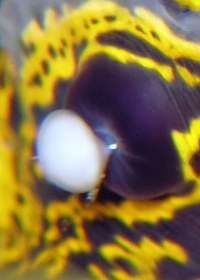
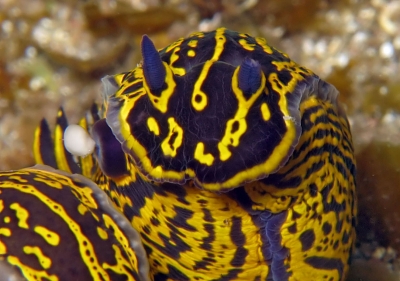

Dear Brian,
Thanks for these photos. It looks like the pair in the middle two photos were interrupted. The white mass you can see by the genital opening of the right animal is a packet of sperm which has clearly lost its way. It seems that during mating the animals were disturbed and while withdrawing their penes back into their bodies this blob of sperm was ejected.
In the lower photo there is a translucent greyish band along the edge of the mantle on each side, and in it you can see opaque white spheres. These are the mantle glands [or MDFs] which are characteristic of chromodorids, and are a place where they store antifeedant chemicals obtained from the sponges they eat. Each genus has a distinctive arrangement of these glands, and in Hyspelodoris there is usually a concentration of this spherical type of gland around the posterior edge of the mantle, and another concentration anteriorly alongside the rhinophores on each side. In this photo we can see the posterior concentration on the right of the photo, and the anterior concentration on the left side.
Finally, I am not sure if I agree with your use of the subspecies name Hypselodoris picta webbi. As I say on the Fact Sheet, there seem to be populations of H. p. webbi and H. p. picta on both sides of the Atlantic so there seems little reason to consider them geographical subspecies. If they are not separated geographically what is separating them? If they are living sympatrically and are genetically isolated doesn't that make them species? I am using the subspecies names for some of the other supposed subspecies of H. picta because they have distinctly different colour patterns and seem to be geographically isolated. I guess I am sitting on the fence on this question. Any other views are welcome.
Best wishes,
Bill Rudman
Re: Hypselodoris picta from near Cannes, France
August 4, 2007
From: Natasja Vandeperre
Concerning message #20094:
Dear Bill,
Unfortunately I never saw them feeding. On my pictures there's also no sign of such a sponge. Next time I will pay attention to the vicinity of Dysidia fragilis.
Greetings,
Natasja
postmaster@naaktslakken.be
Natasja Vandeperre, 2007 (Aug 4) Re: Hypselodoris picta from near Cannes, France. [Message in] Sea Slug Forum. Australian Museum, Sydney. Available from http://www.seaslugforum.net/find/20355Thanks Natasja,
Bill Rudman
Re: Hypselodoris picta from near Cannes, France
July 16, 2007
From: Natasja Vandeperre
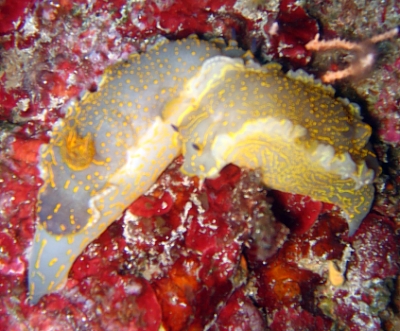
Concerning message #20067:
Hello Bill,
In May I was on a diving holiday in France. I saw a lot of Hypselodoris picta, always the same color variation. As you always ask for pictures of nudibranchs 'doing this', I'm sending you this one. The picture isn't very sharp but you can clearly see what's going on.
Locality: Agay, approx 37 m, France, Mediterranean Sea, 14 May 2007, Reef. Photographer: Natasja Vandeperre.
Natasja Vandeperre
postmaster@naaktslakken.be
Natasja Vandeperre, 2007 (Jul 16) Re: Hypselodoris picta from near Cannes, France. [Message in] Sea Slug Forum. Australian Museum, Sydney. Available from http://www.seaslugforum.net/find/20094Thanks Natasja,
I don't want to sound ungrateful but I also like photos of them feeding - I know its not always easy to be sure, but when you see lots of one species at the same place, it is something worth looking out for. Perhaps you could check your photos for some likely sponges. Some good photos of the sponge it is reported to feed on, Dysidea fragilis, can be found on Picton & Morrow's excellent site Encyclopedia of Marine Life of Britain and Ireland
Best wishes,
Bill Rudman
Re: Hypselodoris picta from near Cannes, France
June 28, 2007
From: Dominique Horst
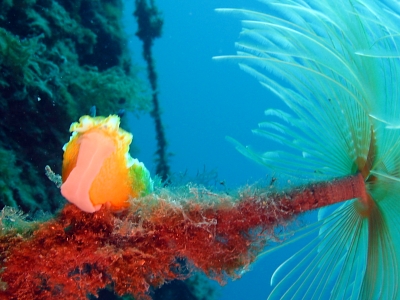

Hello Bill,
Following your reply to message #20030 I can confirm the behaviour of a slug, voluntary releasing itself from where it was crawling. To be honest I helped this giant Hypselodoris picta to crawl on the stalk of this sabellid worm.
Shame on me. The dorid rose up and released itself like it wanted to jump, telling me that it had became bored. Picture are bad, but the behaviour was clear.
Locality: Cap d'Antibes, 20-25m, France, Mediterranean sea, 23 June 2007. Length: 100 mm. Photographer: Dominique HORST.
Kind regards,
Dominique
dominique.horst@wanadoo.fr
Horst, D., 2007 (Jun 28) Re: Hypselodoris picta from near Cannes, France. [Message in] Sea Slug Forum. Australian Museum, Sydney. Available from http://www.seaslugforum.net/find/20067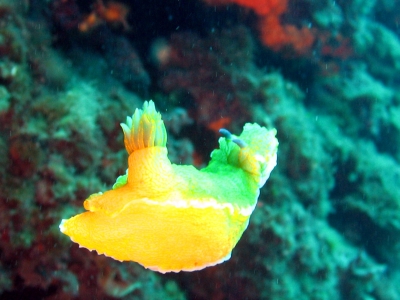
Dear Dom,
Thanks for this graphic example.
Best wishes,
Bill Rudman
Re: Hypselodoris picta with abnormality
June 27, 2007
From: Dominique Horst
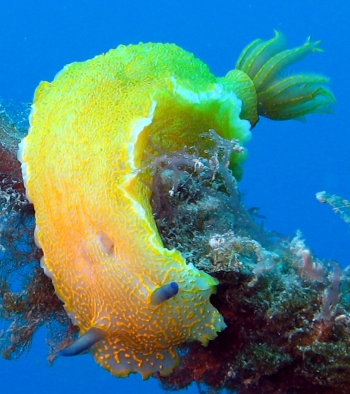
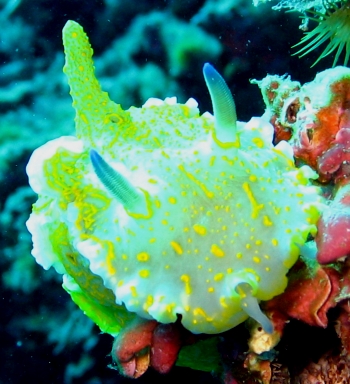
Concerning message #17711:
Hello Bill,
These are more Hypselodoris picta with abnormalities...
The first one could be imagined as a fish bite on the back on the head.
The second one is a bit strange, as it show a kind of horn in skin rising vertically.
Locality: Cap d'Antibes, 20-25m, France, Mediterranean sea, 23 June 2007. Length: 100mm. Photographer: Dominique HORST
Kind regards,
Dominique
dominique.horst@wanadoo.fr
Horst, D., 2007 (Jun 27) Re: Hypselodoris picta with abnormality. [Message in] Sea Slug Forum. Australian Museum, Sydney. Available from http://www.seaslugforum.net/find/20066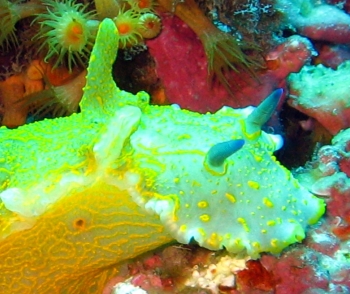
Thanks Dom,
I'm not sure if I can say anything sensible. In the first photo, the patch on the right side of the photo [left side of the animal] certainly seems quite deep. However if you look at Adam Petrusek's photo #11142 from Croatia, you will see H. picta has a pair of translucent regions in that spot, beneath which lie the eyes. It's possible this is a coincidence and a fish has bitten exactly on the spot above the left eye or else the apparent depth of this 'pit' is an optical illusion. I can't really say.
Concerning the 'horns' in the second two photos - it could be damage or it could be a developmental mistake. Also what is the strange blue 'tentacle' pointing out the front from under the mantle in the middle photo?
Best wishes,
Bill Rudman
Hypselodoris picta with abnormality
September 2, 2006
From: Dominique Horst
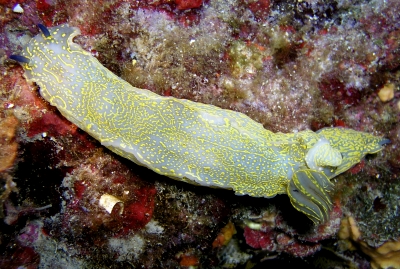
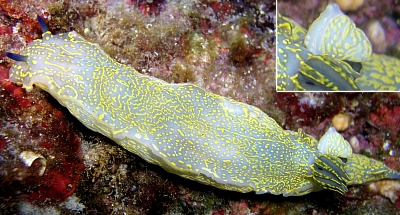
Hello Bill,
Following are two pictures taken by a friend of Hypselodoris picta.
She has noticed an abnormal shape behind the gill. I guess this is one more for the collection of abnormalities...
Locality: Golfe-Juan, 20m, France, Mediterranean sea, 30 August 2006, vertical rock. Length: 15 cm. Photographer: Elisabeth Juan.
Kind regards,
Dominique
dominique.horst@wanadoo.fr
Horst, D., 2006 (Sep 2) Hypselodoris picta with abnormality. [Message in] Sea Slug Forum. Australian Museum, Sydney. Available from http://www.seaslugforum.net/find/17711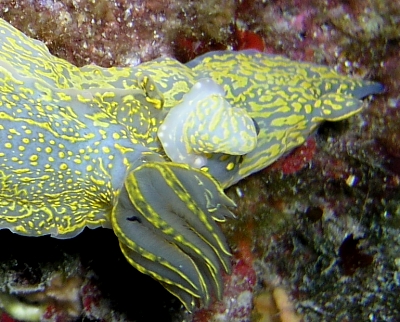
Dear Dominique,
Thanks for the photos. Looking at the strange bit I suspect it may be the result of damage - perhaps a fish bite? - rather than a developmental abnormality, but I can't be sure. If you look at the close-up alongside it almost looks like the whole of the posterior part of the mantle has been partially torn off and folded over to expose the underside. You can see white glands along the edge which are the mantle glands usually seen on the underside. One of life's little mysteries I guess.
Best wishes,
Bill Rudman
Hypselodoris picta from North Carolina
August 19, 2006
From: Vlad Pambucol

Hello
I found those two nudibranch and I was wondering what is their species. I think they are Hypselodoris picta lajensis. Am I right?
Locality: Beaufort, North C,arolina, 115 ft, USA, Atlantic, 30 July 2006. Length: 3 in. Photographer: Vlad Pambucol.
If I am right I found those off the coast of North Carolina USA not off the coast of Brazil.
Let me know
Vlad
vlad.pambucol@rocketmail.com
Pambucol, V., 2006 (Aug 19) Hypselodoris picta from North Carolina. [Message in] Sea Slug Forum. Australian Museum, Sydney. Available from http://www.seaslugforum.net/find/17485Dear Vlad,
Your animals are the widespread Atlantic chromodorid, Hypselodoris picta. Western Atlantic animals used to be called H. edenticulata, but they are now considered to be a regional colour form of the [see message #13023]. The South American colour form has recently been named H. picta lajensis. From photos on the Forum, I wonder whether it can be distinguished by the lack of yellow lines on the gills. There is still some discussion about whether there is only one species or not, but we can't say anythig very sensible until we know more about the regional colour forms. For most we don't even know which sponge they feed on or what their egg ribbon looks like.
There is a photo on the Forum of an animal from North Carolina [message #10813.
Best wishes,
Bill Rudman
Hypselodoris picta from the Canary Islands [2].
August 19, 2006
From: Christian Kowalewski

Hallo,
Could this be a Hypselodoris picta, too. It was taken on the south side of Tenerife (dry side of the Island), - in my earlier message [#17371] I sent a photo taken under a different environment on the north side).
Locality: Tenerife Island, Canary Islands, 10 meters, Spain, Atlantic Ocean, 14 June 2006, Mud covered Stones in Rocky area. Length: 12 cm. Photographer: Christian Kowalewski.
Thanks
Christian Kowalewski
moratorix@gmx.de
Kowalewski, C.J., 2006 (Aug 19) Hypselodoris picta from the Canary Islands [2].. [Message in] Sea Slug Forum. Australian Museum, Sydney. Available from http://www.seaslugforum.net/find/17373Dear Christian,
Yes this is another of the colour forms of Hypselodoris picta.
Best wishes,
Bill Rudman
Hypselodoris picta from Canary Islands
August 19, 2006
From: Christian Kowalewski
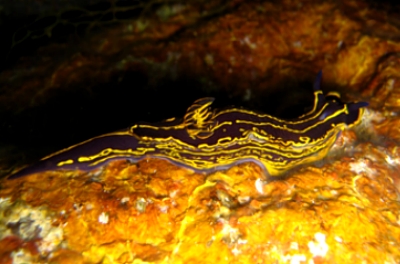
Hallo,
This is my first message to you and in my bad english I want to thank you for this great page and for your work. I am an UW Photographer at the moment living on Tenerife Island, Canary Islands, and working here as Investigacion Tecnician and in my freetime working on making a public license UW Guide (to open it I still need a few weeks, for September it would be).
This photo was taken a few weeks after the summer seas (not so rough) began, in a rocky area in the shallow sublittoral where brown algae such as Cystoseira live. In the early morning there where a lot of Hermodice carunculata (Fire worms); and it was the only day I saw Hypselodoris picta. A few weeks later I found a few 500 meters away.
Locality: Tenerife Island, Canary Islands, 3 meters, Spain, Atlantic, 28 May 2006, Just a few meters below intertidal . Length: 9 cm. Photographer: Christian Kowalewski
Christian Kowalewski
moratorix@gmx.de
Kowalewski, C.J., 2006 (Aug 19) Hypselodoris picta from Canary Islands. [Message in] Sea Slug Forum. Australian Museum, Sydney. Available from http://www.seaslugforum.net/find/17371Dear Christian,
Thanks for this and you other messages which In will post in the next few days. I hope you can keep sending us intersting observations during the time you spend on the Canary Islands.
Best wishes,
Bill Rudman
Hypselodoris picta from near Cannes, France
June 9, 2006
From: Dominique Horst
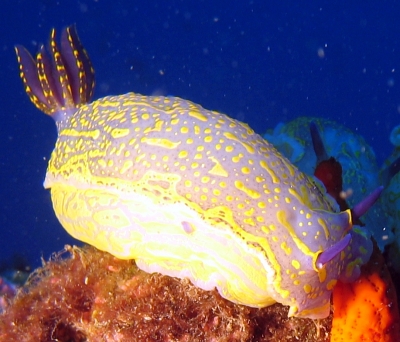
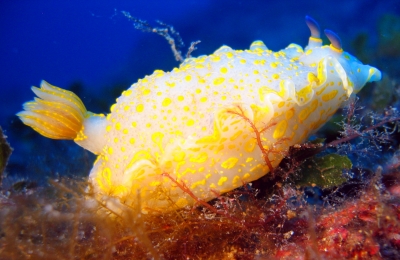
Hello,
I've identified these specimen as Hypselodoris picta. I guess you will confirm. But previously, I got in the literature two different names H. webbi and H. elegans that I could not find in the species list. Are they names for other animals or are they synonyms for the same one ?
Locality: Iles de Lérins, nr Cannes, France, Mediterranean sea, 25 November 2004, vertical rock. Length: 100mm. Photographer: Dominique Horst.
(Colours of the the gills are yellow-blue for one and blue-yellow for the other one on the same picture.)
Kind regards,
Dominique
dominique.horst@wanadoo.fr
Horst, D., 2006 (Jun 9) Hypselodoris picta from near Cannes, France. [Message in] Sea Slug Forum. Australian Museum, Sydney. Available from http://www.seaslugforum.net/find/16772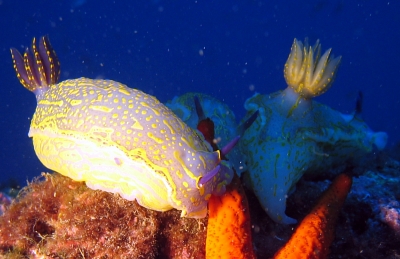
Dear Dominique,
Yes these are H. picta. Because biologists have had a lot of trouble sorting out just how many species of Atlantic 'blue chromodorids' there are, the names and their usage has been quite confused - and still remains so in some cases. So it is not surprising that some books still misidentify species or use the wrong names.
Both H. webbi and H. elegans are synonyms of H. picta. Concerning the colour of the gills in your aniamls. I think the difference is just in the intensity of the blue. One animal has quite a deep blue background colour while the in other the blue pigment is almost absent.
Concerning your being unable to find H. webbi and H. elegans in the species list. The Forum species list only includes species at present on the Forum, it is not a list of all opisthobranch names. I often include major synonyms on the Fact Sheets, so if you are looking for a particular name, which may be a synonym, it often pays to use the general Forum Search facility at the top left of each page. If you do, just use the species part of the name - 'webbi' - not 'Hypselodoris webbi'.
Best wishes,
Bill Rudman
Hypselodoris picta from Italy
October 25, 2005
From: David Shepherd
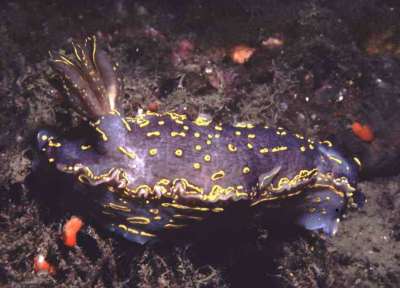
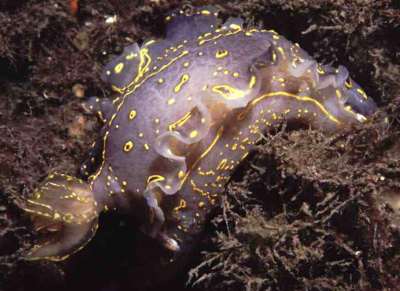
Hello,
Have only just found your web site and pleased to have done so.
My question is, can you identify this species. Is it Hypselodoris webbi?
Also, can the sex be established, and how?
Locality: Pappagallo, Cervo, Italy. Liguria Sea, Mediterranean. Depth: 36 metres. water temp.18c. Length: 12cm (5.75 inches). 6th October 2002
small 80 m. long reef, next to sand. Photographer: David Shepherd
David Shepherd
daveshepherd562@tiscali.co.uk
Shepherd,D.R., 2005 (Oct 25) Hypselodoris picta from Italy. [Message in] Sea Slug Forum. Australian Museum, Sydney. Available from http://www.seaslugforum.net/find/15099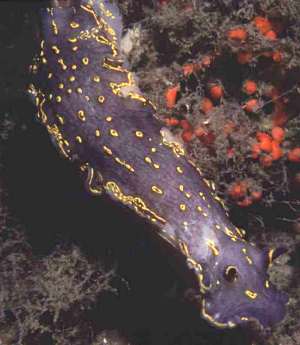
Dear Dave,
This is Hypselodoris picta. Hypselodoris webbi is one of the many names that has been given to this variable species. Concerning the gender of you animal. All sea slugs are hermaphrodite, with a fully functional male and female reproductive system. As far as we know they can't self fertilise, and mating tends to take place whenever two animals of the same species meet.
Best wishes,
Bill Rudman
Juvenile Hypselodoris picta from Sorrento. Italy
September 16, 2005
From: Fabio Russo
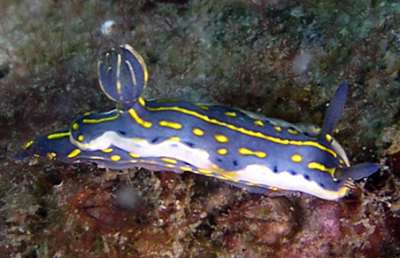
Dear Bill,
I took this shot of a dorid in Sorrento (Naples), but I don't know what species it is!
Locality: Sorrento, Italy, Mar Tirreno. Depth: 15 mt. Length: 9 mm. 15 September 2005. Muddy, Posidonia grass beds. Photographer: Fabio Russo
Can you help me?
Thanks a lot
Best wishes
Fabio Russo
Scercola@alice.it
Fabio Russo, 2005 (Sep 16) Juvenile Hypselodoris picta from Sorrento. Italy. [Message in] Sea Slug Forum. Australian Museum, Sydney. Available from http://www.seaslugforum.net/find/14784Dear Fabio,
This is one of the famous 'blue chromodorids' from the Mediterranean. There are a number of species which look very similar to each other and so they have often been misidentified in both popular books and the scientific literature. I suspect we still have much to learn about them. To make it even more confusing, some of the species change colour pattern as they grow from juveniles to adults. Your photo is of a juvenileHypselodoris picta, which as you will see from other messages on the Forum looks rather different as an adult.
Best wishes,
Bill Rudman
Hypselodoris picta from Turkey
July 4, 2005
From: Ata Bilgili
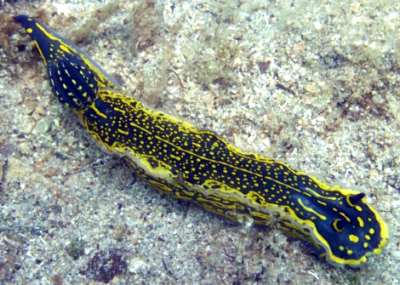
Dear Bill;
Please identify the species and add to your database if you do not have it already (which is unlikely!!!).
Locality: Gulluk, Turkey, Aegean Sea. Isolated and rather undisturbed mainland bay. Depth: 5 m. Length: 10 mm. 26 June 2005. Rock/sand boundary. Photographer: Ata Bilgili
Thank you
Ata Bilgili
ata@dartmouth.edu
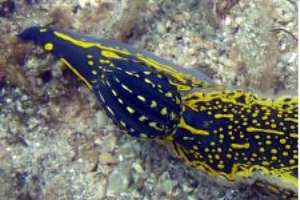
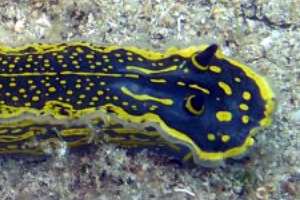
Dear Ata,
This is one of the colour forms of Hypselodoris picta. If I have included close-ups of the gills and anterior end of the body to show details of the colour pattern. If you have any photos of it on its food sponge, or egg-laying, they would be of great interest.
Best wishes,
Bill Rudman
Re: Hypselodoris picta from Florida
March 11, 2005
From: Karen C
Thank you for the information, I have not seen the slug now in 2 days, and am very concerned for his where-abouts. Is there something I should do with the "ribbon" eggs? Do they ever hatch in captivity that your aware of? If so, how long of a time frame are we looking at?
Thank you again for advice.
Karen
pmcrazi@bellsouth.net
Karen, 2005 (Mar 11) Re: Hypselodoris picta from Florida. [Message in] Sea Slug Forum. Australian Museum, Sydney. Available from http://www.seaslugforum.net/find/13318Dear Karen,
Sorry, but there is no good news with the eggs. Often eggs layed in stress are infertile. Even if they did hatch out as microscopic free-swimming larvae, it is very difficult to keep them alive in aquaria without the right algae to feed them. And if by some stroke of luck they did survive, they would then only settle out of the water and become small crawling slugs if their correct food sponge was present - so we are back to square 1.
Bill Rudman
Hypselodoris picta from Florida
March 9, 2005
From: Karen
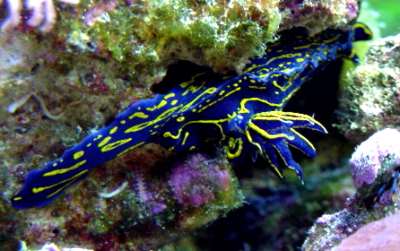
Upon receiving some liverock from a local diver off of the Florida coast [Orlando, Florida, USA], I found a very unusual hitchhiker. It looks to me like a "sea goddess". Dark purple with yellow lines and a "flower" on the back. Looks like Hypselodoris picta. Now today the creature has not been able to be seen, however there is a long pink "ribbon" attached to my liverock, which upon doing some reading looks like eggs. Please see pics for details.
Any recommendations?? thanks
Karen
pmcrazi@bellsouth.net
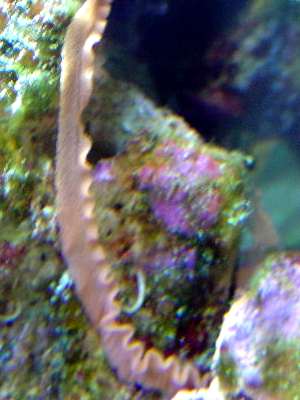
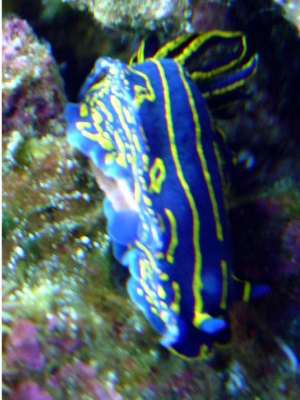
Dear Karen,
Yes this is the Florida colour form of Hypselodoris picta, and those are definitely its eggs. In the lower right photo you can see it laying part of the ribbon. When they lay the eggs like this,in a straight line, this rather than the usual spiral, it is often a sign they are not very happy. I'm afraid that unless you can find the right food for your animal its chances of survival are not good. The sponge it is on in Phillip Gillette's recent message [#13023], which I think is Dysidea etheria, is most probably its food sponge, but its not the sort of item live fish shops stock or can order in with any success. And even if they have it is not not easy to keep alive in an aquarium, especially when it will be eaten alive by the nudibranch.
Best wishes,
Bill Rudman
Hypselodoris edenticulata pictures [2]
February 3, 2005
From: Bill Rudman
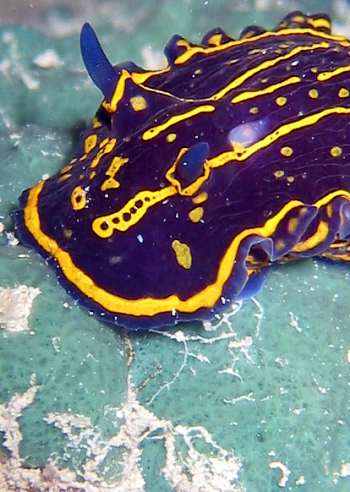
To accompany Phillip Gillette's earlier message [#13023 ], here are some close-ups from them showing some interesting anatomical points.
Upper right: I suspect this animal is on its food sponge
Lower left: Side view of anterior end showing two oral tentacles extending out from under the mantle. Also along the wavy edge of the mantle the whitish mantle glands are clearly visible
Lower right: View of the head and the underside of the mantle. The pair of oral tentacles can be seen and around the mantle edge the whitish mantle glands are visible. Around the anterior end the glands are more elongate than along the sides of the body where they are more spherical [as seen in lower left photo].
Photo Data: Virginia Key, Biscayne Bay, Florida. USA. Depth: 20 ft. Length: approx 7 cm. under a bridge, sponge dominated soft bottom. Photographer: Phillip Gillette
Bill Rudman
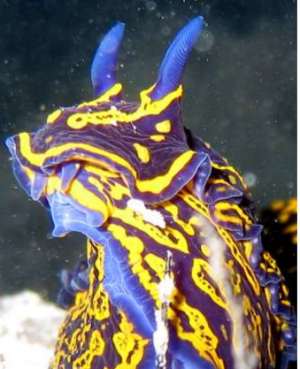
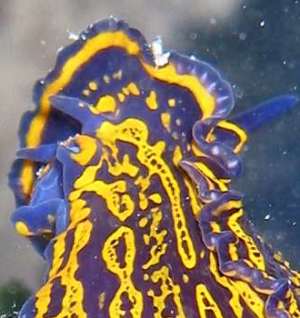
Hypselodoris edenticulata pictures [1]
February 3, 2005
From: Phillip Gillette
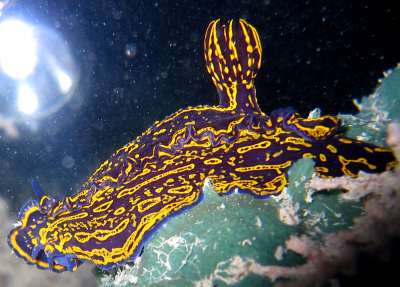
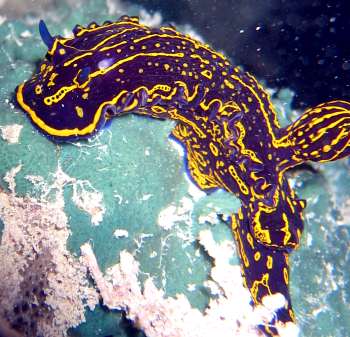
As I mentioned earlier, here are some pictures of Hypselodoris edenticulata that I thought may be helpful. Please feel free to use any, all, or none of them.
Locality: Virginia Key, Biscayne Bay, Florida. USA. Depth: 20 ft. Length: approx 7 cm. under a bridge, sponge dominated soft bottom. Photographer: Phillip Gillette
Phillip Gillette
pgillette1@hotmail.com
Gillette, P, 2005 (Feb 3) Hypselodoris edenticulata pictures [1]. [Message in] Sea Slug Forum. Australian Museum, Sydney. Available from http://www.seaslugforum.net/find/13023Dear Phillip,
Thanks very much for these photos. Firstly, most people who have studied the group consider the Caribbean H. edenticulata to be a regional colour form of the widespread Atlantic Hypselodoris picta. I am following that practice on the Forum at the moment, until the situation is clarified. Certainly if there are different larval development types, as suggested in Lucas Cervera's previous message [#4536], then we would need to rethink the Hypselodoris picta group of species.
I have separated off some close-ups of your photos in to a separate message [#12991] as they show some intersting anatomical features
Best wishes,
Bill Rudman
Hypselodoris picta from Croatia
January 22, 2004
From: Duncan v Vliet
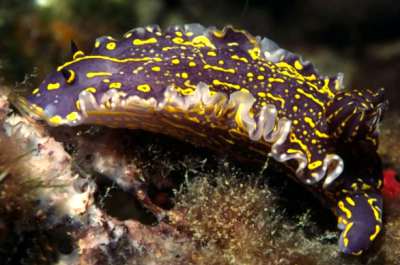
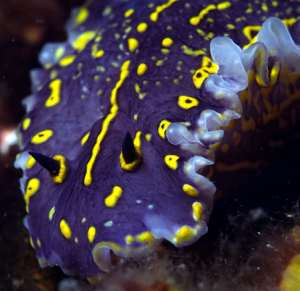
Dear Bill
Is this an Hypselodoris elegans or Hypselodoris picta. I took this photo in Croatia at a depth of 20 meters.
Thanks,
Duncan v Vliet
www.onderwaterwereld.net
duncan@onderwaterwereld.net
v Vliet , D., 2004 (Jan 22) Hypselodoris picta from Croatia. [Message in] Sea Slug Forum. Australian Museum, Sydney. Available from http://www.seaslugforum.net/find/11980Dear Duncan,
The name we use for this species is Hypselodoris picta (Schultz, 1836) although Hypselodoris elegans (Cantraine, 1835) is a year earlier. The reason for this is that Cantraine originally named this species Doris elegans but Quoy & Gaimard had already used the name earlier [Doris elegans Quoy & Gaimard, 1832] for another species. Interestingly Cantraine's Doris elegans was, like yours, from Croatia.
Best wishes
Bill Rudman
Hypselodoris picta from Spain
November 17, 2003
From: Juan
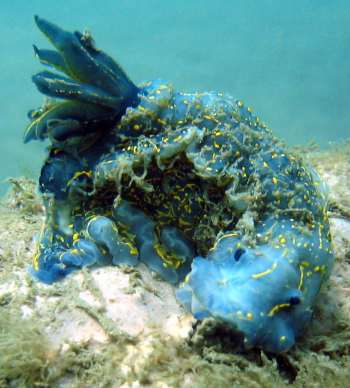
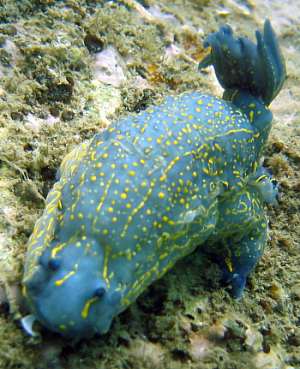
What type of 'Sea Goddess' is this? I ran into this one with light blue with bright yellow spots / some forming streaks / off the coast of the Costa del Sol in southern Spain. Any help would be apreciated.
Juan
Beerios@aol.com
Juan, 2003 (Nov 17) Hypselodoris picta from Spain. [Message in] Sea Slug Forum. Australian Museum, Sydney. Available from http://www.seaslugforum.net/find/11351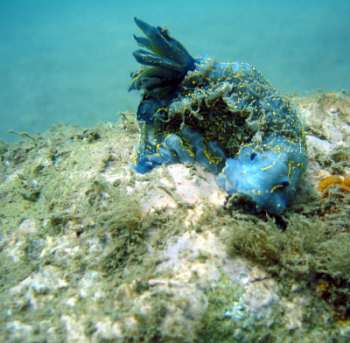
Dear Juan,
This is Hypselodoris picta. If you look at the species Fact Sheet yu will see it has a number of apparent colour forms and a wide distribution on both sides of the Atlantic. It would be interesting to know if the white sponge it is crawling on, and which obviously covers quite a bit of the sea bottom, is something it eats. As far as I know the only food it is reported to eat in the Mediterranean is Dysidea fragilis.
Best wishes,
Bill Rudman
Hypselodoris picta from Croatia
October 7, 2003
From: Adam Petrusek

Dear Bill,
I am sending some images of sea slugs from Adriatic Sea, taken at the unique locality Vrulja on Makarska Riviera, Croatia, on September 16, 2003. This is a place where an underground freshwater river comes into the sea, and the life around is very beautiful.
This one is a 'portrait' of Hypselodoris picta. Depth 13 m.
Thanks for the help.
Adam Petrusek
Charles University
Prague, Czech Republic
petrusek@cesnet.cz
Petrusek, A., 2003 (Oct 7) Hypselodoris picta from Croatia. [Message in] Sea Slug Forum. Australian Museum, Sydney. Available from http://www.seaslugforum.net/find/11142Thanks Adam,
Bill Rudman
Hypselodoris picta from Nth Carolina
August 26, 2003
From: Sandy Smith
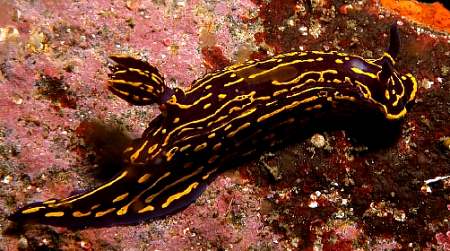
Bill,
Thanks so much for getting back to me quickly. The specimen that I have photographed was taken on Aug 15. I would guess it to be about 2" in length.
Here is a photo of the most common type of nudibranch in North Carolina waters. This one was taken on Aug 17 on the wreck of the 'Caribsea'.
Sandy Smith
scubanurse69@hotmail.com
Smith, S., 2003 (Aug 26) Hypselodoris picta from Nth Carolina. [Message in] Sea Slug Forum. Australian Museum, Sydney. Available from http://www.seaslugforum.net/find/10813Thanks Sandy,
This is the typical Caribbean form of the widespread Atlantic species Hypselodoris picta
Best wishes,
Bill Rudman
Hypselodoris picta from Israel
July 25, 2003
From: Ilan Ben Tov

Hi Bill,
This beauty was pictured last automn in Haifa Bay in Israel at depth of 25 meters in the wreck of the Shire.
The picture was taken by my dive buddy Naftali Blau and I send it with his permission.
Ilan.
ilanbt@gilat.com
Tov, I.B., 2003 (Jul 25) Hypselodoris picta from Israel. [Message in] Sea Slug Forum. Australian Museum, Sydney. Available from http://www.seaslugforum.net/find/9651Dear Ilan,
This is on of the many colour forms of Hypselodoris picta
Best wishes,
Bill Rudman
Hypselodoris picta
May 20, 2003
From: Chris
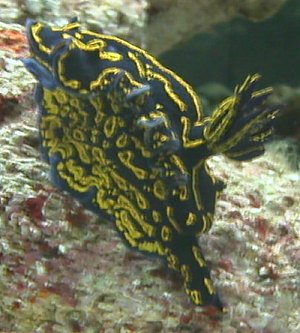
I was curious if anyone might recognize what species this slug is. It was a gift to me from a friend, and I was just wanting to read up on it a little. The closest guess I can get is that it is some sort of Chromodoris possibly.
Thank you for your help.
Chris
cmturn0@uky.edu
Chris, 2003 (May 20) Hypselodoris picta. [Message in] Sea Slug Forum. Australian Museum, Sydney. Available from http://www.seaslugforum.net/find/9452Dear Chris,
Any idea where it was found? This is Hypselodoris picta, and it looks quite like the European/Mediterranean form.
Best wishes,
Bill Rudman
Hypselodoris picta feeding
March 22, 2003
From: Linda Ianniello
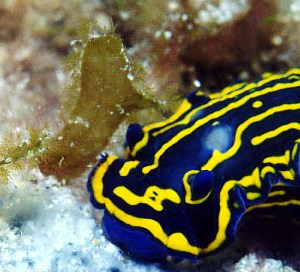
Hi, Dr. Bill,
We have seen quite a few Hypselodoris picta locally, but I have never been able to catch one feeding. I finally got proof last week that it eats the same blue sponge as Hypselodoris sp. 4. [see my earlier message].
This photo is from Deerfield Beach, Florida, USA and was taken at a depth of 12' off the beach, in February, 2003.
Linda Ianniello
lindai@us.ibm.com
Ianniello, L., 2003 (Mar 22) Hypselodoris picta feeding. [Message in] Sea Slug Forum. Australian Museum, Sydney. Available from http://www.seaslugforum.net/find/9374Thanks Linda,
A very useful piece of information. Have you by chance a photo that shows more of the sponge colony? Comparing your photo and Anne Dupont's photo of Hypselodoris sp. 4. feeding makes me wonder if they are feeding on two different sponges. If we forget the colour differences, the texture in your sponge seems to be more solid and less fibrous than Anne's sponge, but that may just be because your photo shows a very close-up view of the sponge.
Best wishes,
Bill Rudman
Hypselodoris picta from Croatia
December 20, 2002
From: Frank Thijssen
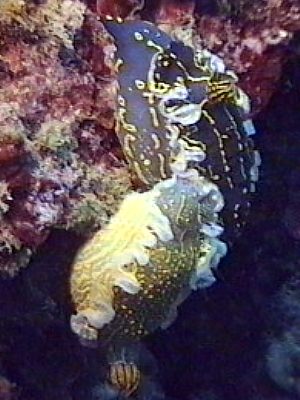
Dear Bill,
Here is another photo of a nice slug,
for the Forum. I don't know the name of the species.
Divesite: South coast of Croatian.
Location: SV-Marina
Depth: 28m
Watertemp: 22 degrees
Animal was on steep rocks (sleeping)
Two specimens - male & female.
Frank Thijssen
f.thijssen5@chello.nl
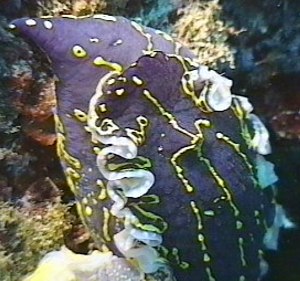
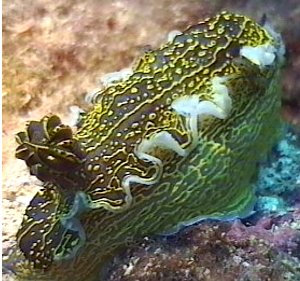
Dear Frank,
This is the chromodorid Hypselodoris picta. If you have a look at other messages on this page you will see that it has quite a few colour forms, some of which are found on the American side of the Atlantic Ocean. You mention a male and a female. All sea slugs are hermaphrodite, which means they have fully functional male and female reproductive systems. They cannot fertilise their own eggs, but it does mean that every time they do meet and mate, they have double the chance of producing some offspring.
Best wishes,
Bill Rudman.
Thanks
December 11, 2002
From: Joel Penland
Dr Rudman,
Thank you for the opportunity to submit photos and contribute to your awesome website. "Especially thank you" for all your work producing your site, the time you dedicate to it, and all the great information that is available for our access on a worldwide basis.
I, like many divers, have been fascinated by these little creatures and their diversity in color, shapes and sizes, and the locations where they have been observed. Your Forum has offered great insight and education to understanding these little friends of the sea. Also, I am sure all the nudibranchs are very thankful for your Forum by educating divers not to physically disturb them.
Best Regards,
Joel Penland
www.jpenland.com
Penland, J., 2002 (Dec 11) Thanks. [Message in] Sea Slug Forum. Australian Museum, Sydney. Available from http://www.seaslugforum.net/find/8629Dear Joel,
Glad you find the Forum useful. There are very few of us who are lucky enough to be paid to study nudibranchs and so learning more about them happens very slowly. I am sure divers observe and photograph these animals 'doing things' we professionals are unaware of. Hopefully the Forum can be a place where we can learn a lot from each other.
Best wishes,
Bill Rudman
Hypselodoris picta from South Carolina
December 5, 2002
From: Joel Penland
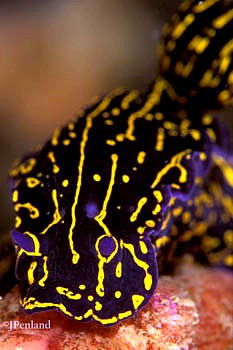
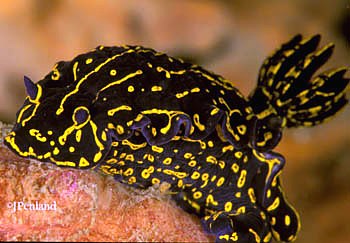
I have encountered this majestic nudibranch [Regal Sea Goddess] on the General Sherman shipwreck 6 miles offshore the South Carolina Coast (Little River, SC). I have seen as many as a dozen in one area. They make excellent photographic subjects. I have enclosed several photos.
Joel Penland
www.jpenland.com
JPenlandUW@aol.com
Penland, J., 2002 (Dec 5) Hypselodoris picta from South Carolina. [Message in] Sea Slug Forum. Australian Museum, Sydney. Available from http://www.seaslugforum.net/find/8551Dear Joel,
This species is generally considered to be a colour form of Hypselodoris picta but as I discuss in an earlier message there is some suggestion that it is biologically distinct and should still be called Hypselodoris edenticulata. If you find it quite commonly, it would be very interesting to have some photos of it feeding on its food sponge and with its egg ribbons as this is one quick way of comparing it with similarly coloured animals from other parts of the Atlantic.
Best wishes,
Bill Rudman
Hypselodoris picta? from Spain
October 22, 2002
From: Isidro Cuallado
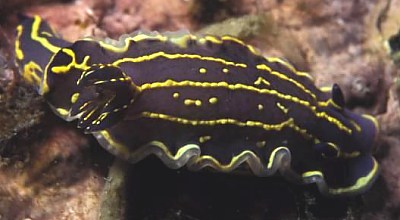
Dear Bill,
These photos were taken in La Herradura, Granada, Spain, 7 Sep. 2002 from -12 to -18m.
I wonder if they all correspond to the same species and my best guess is that it is Hypselodoris picta, but I am not fully convinced.
They were crawling basically on rocks covered by algae.
Regards,
Isidro Cuallado
icuallado@airtel.net
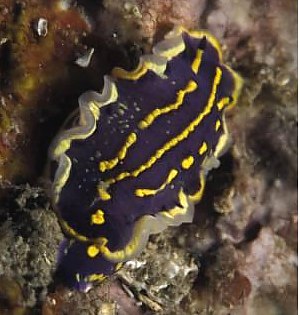
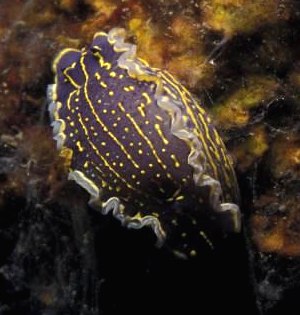
Dear Isidro,
It is wise not to be 'fully convinced' when trying to identify these blue chromdodorids, but I am pretty sure in this case they are all Hypseldoris picta. According to Angel Valdes, this is the only eastern Atlantic species of Hypselodoris, other than Hypselodoris villafranca, with more than two parallel yellow lines on the dorsum. It is also characterised by the uniform dark blue rhinophore clubs and the yellow lines along the gill rachis.
Best wishes,
Bill Rudman
Hypselodoris picta from the Mediterranean (1)
August 6, 2002
From: Marina Poddubetskaia
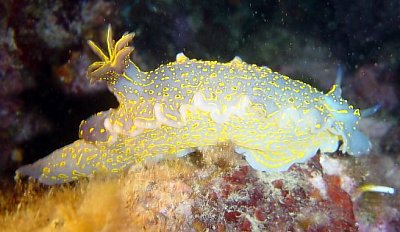
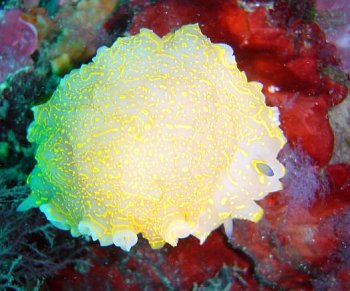
Dear Bill,
There are photos of two colour forms of Hypselodoris picta. See separate message for close-ups of gills.
Upper: blue colour form
Date: July 04, 2002
Location: Cerbere, France [Mediterranean coast]
Site: Cap Negre, night dive
Depth: 19m
Size: 15-16cm
Lower: yellow colour form
Date: July 02, 2002
Location: Cerbere, France
Site: Cap Negre
Depth: 23m
Size: 8-9cm
Photos: Marina Poddubetskaia - Nembro website
Best wishes,
Marina.
nembro@nembro.info
Poddubetskaia, M., 2002 (Aug 6) Hypselodoris picta from the Mediterranean (1). [Message in] Sea Slug Forum. Australian Museum, Sydney. Available from http://www.seaslugforum.net/find/7574Thanks Marina,
Bill Rudman
Hypselodoris picta from the Mediterranean (2)
August 6, 2002
From: Marina Poddubetskaia
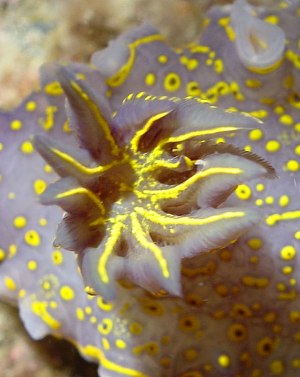
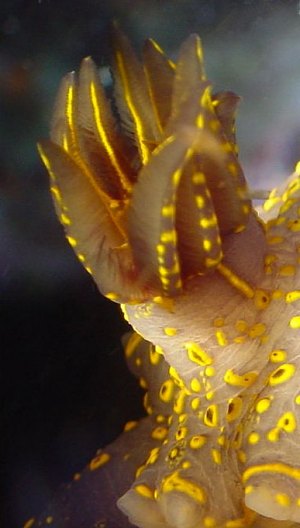
Dear Bill,
Here are some close-ups of the gills of the
two colour forms of Hypselodoris picta in my other message.
Upper: blue colour form
Date: July 04, 2002
Location: Cerbere, France [Mediterranean coast]
Site: Cap Negre, night dive
Depth: 19m
Size: 15-16cm
Lower: yellow colour form
Date: July 02, 2002
Location: Cerbere, France
Site: Cap Negre
Depth: 23m
Size: 8-9cm
Photos: Marina Poddubetskaia - Nembro website
Best wishes,
Marina.
nembro@nembro.info
Poddubetskaia, M., 2002 (Aug 6) Hypselodoris picta from the Mediterranean (2). [Message in] Sea Slug Forum. Australian Museum, Sydney. Available from http://www.seaslugforum.net/find/7617Thanks Marina,
Bill Rudman
Hypselodoris picta from Greece
March 19, 2002
From: Fons Sarneel
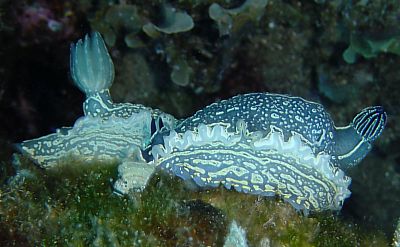
Dear Bill,
Here is a photo of a second slug my wife and I saw while diving last year, [31 August, 2001] near the island Crete, Greece. To be specific, we were at the coast of the isle "Dia", which is an uninhabited "rock" close to the north coast of Crete.
We found them at a depth of somewhere between 15 and 25 meters. Not too far from the slugs in thisphoto we also found an egg-ribbon. I didn't include the picture of the eggs, because I'm not sure it was deposited by the slugs in the other picture.
Yours sincerely,
Fons Sarneel
fons@sarneel-2.myweb.nl
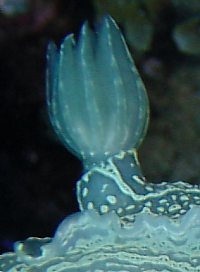
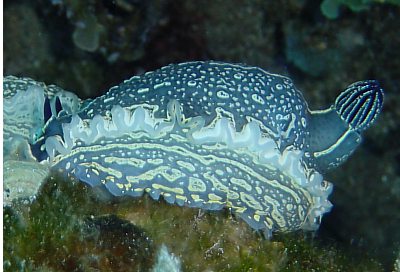
Dear Fons,
I hesitate to identify a 'blue chromodorid' from the Meditrraneanbecause there are many very similarly coloured species in that region. However I think I am pretty safe in identifying this one as Hypselodoris picta. This fairly large species is found on both sides of the Atlantic, and on the Atlantic islands, and if you have a look at the Fact Sheet you will see it has a number of fairly recognisable colour forms or subspecies.
If you have any other photos of nudibranchs they would be very welcome, even if you have identified then, as they gives us information on colour variation and the geographical distribution of these species.
Best wishes,
Bill Rudman
Information on Hypselodoris picta
January 31, 2002
From: Joe Helferich
My LFS (The Fish Tank in Alamogordo, NM, USA) recently received 2 of what we think are Hypselodoris picta, they are dark purple/black with gold/yellow striping. They are about 3 inches in length. Since being received on early morning the 22nd [Jan 2002] there are 2 new egg ribbons probably 4-5 inches in total length :) these are the only 2 creatures in a 75 gal tank and now nothing else is going in. They seem to be picking.. very little.. at a brownish/black sponge on a piece of rock, some algae spots, and observed "catching" brine/mysis shrimp in their "tentacles" and it disappears. Is there any further info on feeding habits and care of the young that might (keeping fingers crossed) hatch ??
Thanks
Joe
munchieiam@yahoo.com
Helferich, J., 2002 (Jan 31) Information on Hypselodoris picta. [Message in] Sea Slug Forum. Australian Museum, Sydney. Available from http://www.seaslugforum.net/find/6095Dear Joe,
I really haven't much to add to what I have said about similar questions on this page and on the Keeping in captivity Page.
Species of Hypselodoris feed exclusively on sponges. I am not sure what your observation that brine shrimps seem to disappear into their tentacles means but it has nothing to do with feeding. The head tentacles [rhinophores] are sense organs and the feathery gills are for breathing.
Concerning the eggs. According to Lucas Cervera in an earlier message, the eggs of H. picta should be relatively large and the young should hatch directly from them as small crawling slugs without a free-swimming larval stage. While it is easier to breed them if you don't have to look after free-swimming larvae, the young will only survive if they have an immediate supply of their food sponge. So we are back to square one again.
If you have a photo of the nudibranch, and the eggs, it would be a useful bit of information, but I am afraid keeping either the adults, or the young alive if they hatch, depends on getting a supply of their food sponge.
Best wishes,
Bill Rudman
Mystery photo of 'Greek Goddess'
December 11, 2001
From: Anonymous
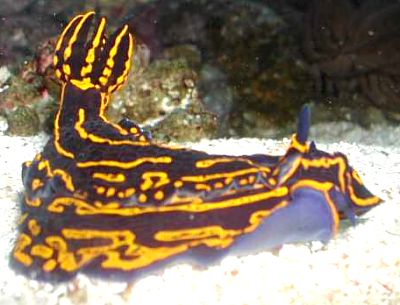
Someone has sent this photo of what looks like the Caribbean form of Hypselodoris picta. Can they please let me know who they are and send some information on where the animal came from. Just send an email to the address below
Thanks,
Bill Rudman
billr@seaslugforum.net
Anonymous, 2001 (Dec 11) Mystery photo of 'Greek Goddess'. [Message in] Sea Slug Forum. Australian Museum, Sydney. Available from http://www.seaslugforum.net/find/5799Hypselodoris picta and sponge
November 7, 2001
From: Luis Sánchez Tocino
Dear Dr. Rudman
The sponge of the H. picta in the lower left photo [size: 40 mm; depth: 8m; 21 August 1998; Almuñecar (Granada) Spain] in my earlier message is Ircinia cf. fasciculata.
Luis
lstocino@ugr.es
Sánchez Tocino, L. , 2001 (Nov 7) Hypselodoris picta and sponge. [Message in] Sea Slug Forum. Australian Museum, Sydney. Available from http://www.seaslugforum.net/find/5643Thanks Luis,
Bill Rudman
Hypselodoris picta from Spain
November 5, 2001
From: Luis Sánchez Tocino

Dear Dr. Rudman
Here are some photos of Hypselodoris picta Schultz from Almuñecar, Granada Coast, Spain.
UPPER RIGHT: size: 100 mm; depth: 7 m; 4 November 1998; Almuñecar (Granada) Spain
LOWER LEFT: size: 40 mm; depth: 8m; 21 August 1998; Almuñecar (Granada) Spain
LOWER RIGHT: size: 110 mm; depth: 13 m; March 1998; Almuñecar (Granada) Spain
Luis
lstocino@ugr.es


Thanks Luis,
This is certainly a very variable species. Your upper photo looks very like animals from the Western Atlantic.
Bill Rudman
Sea Goddess Nudibranch
August 25, 2001
From: Frank Winston
Hello,
I have been trying to get as much info as I can on Hypselodoris picta. Unfortunately I found your site a little too late. I purchased a Regal Sea Goddess Nudibranch with blue sponges (it just arrived a few hours ago), and thought I could share some info. Within a few hours of arrival it consumed half of the sponge that was shipped with it. I have also found out that the sponges are almost impossible to keep alive for more than a few days. I am anticipating that to keep this species alive and thriving I am going to have to have the sponges shipped weekly, which is really not practical. It sounds like their are a few people out there that think it might also consume algae. I have found out otherwise, the sponge is all it eats. Perhaps a local dealer that receives shipments from the Keys won't mind adding a few blue sponges a week. I will keep you informed on any observations. I will also do more homework before adding new species to my reef.
Frank Winston
Salem, NC
kcindys@earthlink.net
Winston, F., 2001 (Aug 25) Sea Goddess Nudibranch. [Message in] Sea Slug Forum. Australian Museum, Sydney. Available from http://www.seaslugforum.net/find/5145Dear Frank,
It definitely seems that buying animals for aquaria is definitely a case of 'buyer beware'. One thing that does concern me is that the regular harvesting of specific sponge colonies to feed nudibranchs could cause serious ecological damage quite quickly. Many of these sponges are not that common and take many years to grow. In nature they will occasionally be found by a hungry nudibranch and partially consumed, but usually enough of the colony survives to regrow. If however the whole colony is removed for the aquarium trade - it's gone forever.
Nudibranchs are certainly beautiful, but they are best left in their natural environment.
Thanks for keeping us informed
Best wishes,
Bill Rudman
Re: Hypselodoris edenticulata from Florida
July 18, 2001
From: Maria
Anne
I have also seen this slug off of Boca Raton, Florida, on a wreck ("J.Scuddy"). I thought it was absolutely beautiful. I have never seen anything like it. I am glad to hear that there are others close by.
Maria
maria@bollmanyachts.com
Maria, 2001 (Jul 18) Re: Hypselodoris edenticulata from Florida. [Message in] Sea Slug Forum. Australian Museum, Sydney. Available from http://www.seaslugforum.net/find/4848Dear Maria,
You may have noticed in the messages that we are very interested in knowing what sponge this animal eats and what its egg ribbon looks like. If you ever see it eating a sponge, or always on the same sponge, or see it laying an egg ribbon, and have a chance to take a photo or two, we would be very grateful. I am happy to scan photos here and return them to you if you are unable to scan then yourself. Just let me know and I will give you my postal address
Best wishes,
Bill Rudman
Hypselodoris edenticulata from Florida
July 14, 2001
From: Anne DuPont

Hi Bill,
Here is a photo of Hypselodoris edenticulata from Florida, USA.
Photo taken by Anne DuPont
June 23, 2001 off Delray Beach, Florida in 92 feet of water in the sand.
This Hypselodoris edenticulata was almost 5 inches long and was actively swimming along. It's coloring was navy blue with brilliant yellow-gold stripes with a large crown of gills. We don't see them often in Florida except at this wreck.
I was surprised to receive a photo and e-mail from a fellow underwater photographer in South Carolina who just photographed this little guy off shore on a South Carolina shipwreck. This shipwreck is 6 miles off shore near the North Carolina-South Carolina border. I thought you would be interested in knowing it's Atlantic range. When I return to photograph it again, I'll look for egg masses and try to get photographs of the different sponges on the wreck and see if I can find any feeding on the sponges.
Thank you again for all the work you do on the Forum.
Best wishes,
Anne DuPont
Delray Beach, Fl
adupont@gate.net


Dear Anne,
Thanks for the photo. It's good to have a good one of this Caribbean form as I get quite a few queries about it. As I discuss at the top of the page there is oe group who consider H. edenticulata to be a synonym of the H. picta but Lucas Cervera suggested recently that there is some doubt about whether there are biological differences. I have left it on the H. picta page but any information on food and eggs would be very helpful.
best wishes,
Bill Rudman.
Hypselodoris picta from the Adriatic Sea
July 1, 2001
From: Buga Berkovic
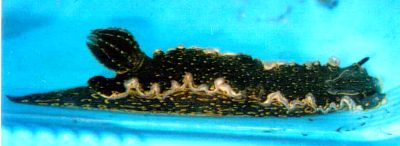
Hi!
I have found something which looks very much like the photos on the Forum of Hypselodoris picta & the slug from Florida only it's more green, in fact it is dark green with lot of yellow dots that sometimes form lines. There were six of them together, about 3 meters deep and not more than 15 meters from the coast. Bottom was mostly sand, some rocks, covered with vegetation.
My problem is this: I can't find any literature on it, or whether anything like it has been found in the Adriatic sea, where I've found them. So the most important thing I wish to ask you is if you know do they live here, and if yes - which species.
I'm just an amateur-diver (not yet SCUBA, but soon) so unfortunately I don't have an underwater camera, but I took these animals out and put them in a bucket full of water and took the pictures. I was watching them for 5 days - every day I found them somewhere near the location where I found them the first day. I have total of allmost 35 photos! If needed, I also have a picture of a baby, about 0.6 cm long!
Animals range in length from about 5 cm to around 17 cm when fully stretched (see on the picture!). I found them in south Adriatic near Dubrovnik area (island of Korcula). I hope you can tell me what are they, because I have started to be very interested in them, and I'm even going to try to study marine biology in Vienna so I could professionaly work on them in future! If any more details are needed just say and I'll try to give them to You!
Thanks a lot!
Buga Berkovic
Zagreb
Croatia
bugamatea@yahoo.com
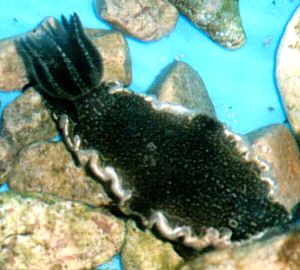
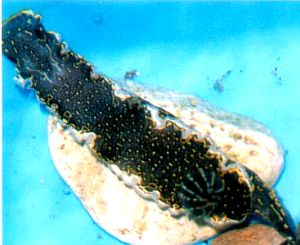
Dear Buga,
I am pretty sure your animal is Hypselodoris picta, which is quite variable in colour. However there are quite a few similarly coloured species in the Mediterranean and nearby waters so I think we should wait for confirmation from one of the European workers more familiar with the local fauna. Do all the animals you have found have spots, like in the photos, or do some have lines instead? If there are lined specimens a photo of one of these would be interesting.
We know very little about the basic natural history of these animals so if you were able to find what sponge it was feeding on, and perhaps photograph it, and photograph its egg ribbon, that would be useful. I realise that this may all be impossible, when you are limited to photographing in a bucket, but I am always optimistic.
Best wishes,
Bill Rudman
Possible food source for Hypselodoris edenticulata
June 8, 2001
From: Mike Bloss
At the following site www.athiel.com/lib10/frakes1.htm I read:
"Colorful Live Rock Organisms
... These blue sponges are thought to be the food of the colorful Greek goddess nudibranch
(Hypselodoris edenticulata). These beautiful creatures only feed on this ..."
I'm unable to contact them for confirmation, the browser I'm stuck with won't allow me to send them a message, but if they can provide the neccesary sponge it would be a boon to everyone who acquires one of these animals.
Mike Bloss
mbloss@uswest.com
Bloss, M., 2001 (Jun 8) Possible food source for Hypselodoris edenticulata. [Message in] Sea Slug Forum. Australian Museum, Sydney. Available from http://www.seaslugforum.net/find/4525Dear Mike,
Thanks for the information. For those who don't know, Hypselodoris edenticulata is an unnecessary name for the Caribbean colour form of Hypselodoris picta which is at times for sale in aquarium shops. I've had a look at the website. They mention that one of the blue sponges is a species of Dysidea but the important point is that site says that the sponges are thought to be the food of H. edenticulata..
I have mentioned a number of times in the Forum that species of Dysidea have been reported as food for various chromodorids so the mention of Dysidea as a possible food is not an unreasonable suggestion but we still need some evidence. Even if it turns out to be Dysidea, these sponges are extremely difficult to relocate, and if they die in an aquarium are likely to kill a lot of other animals in the process as they foul the water and release toxic chemicals. I basically don't think keeping nudibranchs in aquaria is a good idea unless you have special facilities, know the food and have ready access to fresh stocks of the food.
Best wishes,
Bill Rudman.
Re: Possible food of Hypselodoris edenticulata
June 8, 2001
From: Juan Lucas Cervera
Dear Bill,
Chris Todd and I have a Spain-UK short grant to carry out some studies concerning the development of some species of nudibranchs from UK and the southern Spain. One of the targeted species is Hypselodoris picta which according to Clark & Goetzfried (1978) (they called the Caribbean animals H. edenticulata) shows direct development. However, the specimens from the Strait of Gibraltar have spawns from which planktotrophic larvae hatch. So:
•1. Is it possible H. edenticulata is different from H. picta?
• 2. Is it possible H. picta can show a different type of development depending of the geographical area or food availability?
Obviously, more studies are needed.
Reference:
• Clark, K.B. & Goetzfried, A. 1978. Zoogeographic influences on development
patterns of North Atlantic Ascoglossa and Nudibranchia, with a discussion of
factors affecting egg size and number. Journal of Molluscan Studies, 44: 283-294.
Regards.
Lucas.
lucas.cervera@uca.es
Cervera, J.L., 2001 (Jun 8) Re: Possible food of Hypselodoris edenticulata. [Message in] Sea Slug Forum. Australian Museum, Sydney. Available from http://www.seaslugforum.net/find/4536Dear Lucas,
It sounds very interesting. I look forward to learning of your results. If anyone in the Caribbean finds this animal alive it would be well worth checking out its egg mass and development type. If it lays an egg mass in an aquarium keep it safe until you can see if crawling slugs or swimming larvae hatch out. If its in the wild, a close-up photo of the egg mass could provide important clues.
Best wishes,
Bill Rudman
Can you identify a species & it's diet
April 13, 2001
From: Brad Anderson
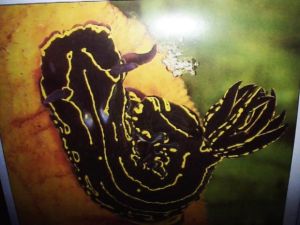
The nudibranch I am trying to identify is a deep dark blue, almost black in color, with narrow bright yellow meandering lines running lengthwise on it's body, and a large gill tuft on the rear top of its body with the same markings. Length about 3" or 70mm, about 1/2" or 1.5 cm in diameter.
I've attached a jpg, a picture can also be seen on on page 161, the upper right hand side of the page in The Manual of Marine Invertebrates by Martyn Haywood and Sue Wells, Copyright 1989 Salamander Books Ltd, Published by Tetra Press, Blacksburg,VA 24060, ISBN# 1-56465-139-8.
In that book it is identified as an 'Indian Ocean Glossodoris sp.', with no other details. Upon searching this Forum index I cannot find a similar Glossodoris shown. I don't know how reliable this identification is from this book.
I am a reef aquarium keeper/amateur biologist and have found one of these displayed in one of the local aquarium stores. I am interested in identifying it and it's diet to help maintain it's longevity and possibly try to breed it in captivity. Any help would be appreciated. Thanks!
Brad
brada1_mn_com@hotmail.com
Anderson, B., 2001 (Apr 13) Can you identify a species & it's diet. [Message in] Sea Slug Forum. Australian Museum, Sydney. Available from http://www.seaslugforum.net/find/4164Dear Brad,
You can't always believe everything you read in books. Your photo is of a chromodorid called Hypselodoris picta a species which has a wide distribution on both sides of the tropical Atlantic. This photo seems to be of the Caribbean color form which used to be called Hypselodoris endenticula. Where did you take your photo?
If you look at the messages below yours on this page you will find a number of recent messages discussing what the Caribbean colour form feeds on. At present we are waiting to see if someone can send us a photo of the sponge it feeds on. basically it will be a specialised sponge feeder and it would be difficult to keep the sponge alive in your aquarium even if you discovered which species it was and could find some.
Sorry I can't be more positive about keeping nudibranchs in captivity but they are much more difficult than most fish.
Best wishes,
Bill Rudman
Re: Food of Hypselodoris picta
April 4, 2001
From: Mark Bass
Dear Bill,
I will ask my friend if he can forward a picture of the sponge and maybe a picture of
the nudibranch eating the sponge in the wild. I know he found which sponge it was by observing H. picta feeding while diving.
Mark
Mark.Bass@drkw.com
Bass, M., 2001 (Apr 4) Re: Food of Hypselodoris picta. [Message in] Sea Slug Forum. Australian Museum, Sydney. Available from http://www.seaslugforum.net/find/4113Thanks Mark,
Bill Rudman
Re: Hypselodoris picta
April 3, 2001
From: Mark Bass
I talked to a friend who is a diver in Florida and he confirmed that Hypselodoris picta is a sponge eater. He has this nudibranch at home and collects sponge from the wild which it eats and it has done well. However, the sponge will not live in the aquarium for more than a couple of days (no matter how hard he tries and he has tried). The eaten sponge rapidly deteriorates. So, unless one has easy access to the ocean on a fairly regular basis, do not purchase this nudibranch.
Mark Bass
Mark_bass@wasserella.com
Bass, M., 2001 (Apr 3) Re: Hypselodoris picta. [Message in] Sea Slug Forum. Australian Museum, Sydney. Available from http://www.seaslugforum.net/find/4053Thanks Mark,
It would be nice if your friend could send us some photos of Hypselodoris on its sponge. As far as I can discover there is no record of just which sponge this animal eats. As your frind has experienced, it is very difficult to keep sponges alive in aquaria, especially when they are being slowly eaten.
Best wishes,
Bill Rudman
Food of Hypselodoris picta
April 3, 2001
From: Shawna
I have just identified a nudibranch I just bought from the Sea Slug Forum. He looks exactly like your picture (deep blue with yellow). I also was told that he eats algae. From all my reading here, I guess it's safe to assume that he also eats sponges. So what do I do from here on out to try to keep this species alive? The lfs had him for almost 3 weeks before I bought him. They were supposedly feeding him invert food and algae.
Shawna
d.ns@gte.net
Shawna, 2001 (Apr 3) Food of Hypselodoris picta. [Message in] Sea Slug Forum. Australian Museum, Sydney. Available from http://www.seaslugforum.net/find/4089Dear Shawna,
It's safe to assume that your slug eats sponges but its not safe to assume it 'also eats sponges' which suggests it eats something else (sea weed?) as well. Nudibranchs, including all dorids, are carnivorous and their digestive system and its enzymes are designed to eat animal matter not plant material.
If the people you bought it from say it eats 'invertebrate food and algae' they clearly don't know what they are talking about, or else are misleading you. it looks like you went to the same shop as Mark Bass who has been asking the same questions. With luck he wil be able to get some photos of the sponge this species feeds on. This will not be much help for your starving animal but will at least showpotential buyers what it actually eats.
Best wishes,
Bill Rudman
Hypselodoris picta
March 23, 2001
From: Mark Bass
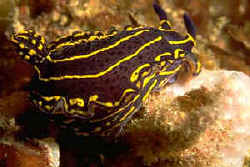
Thanks for your reply. I saw the Hypselodoris picta for sale at a LFS. The sales people said it is an algae eater. But after a look through this site, I would think this is not accurate. Could you please share information on the diet of this nudibranch. If it is a sponge eater, are the types of sponges even available for sale. I am happy that I looked to your site before making this purchase. I am attaching a picture below from a web site which also sells this Nudibranch.
Thank you for your help.
Mark Bass
Mark_bass@wasserella.com
Bass, M., 2001 (Mar 23) Hypselodoris picta. [Message in] Sea Slug Forum. Australian Museum, Sydney. Available from http://www.seaslugforum.net/find/4028Dear Mark,
Your animal certainly looks like the Florida form of H. picta which used to be called Hypselodoris edenticulata (White, 1952). Your animal is definitely a sponge feeder and I am sure that like most chromodorid nudibranchs it will only eat one or two species of sponge, but I am afraid I don't know what those sponges are and can find no record in the literature. I am pretty sure the aquarium shop will not stock the right sponges and it is definitely not an algae eater.
Best wishes,
Bill Rudman
Nudibranch - Blue with Yellow Spots
March 22, 2001
From: Mark Bass
I would like assistance in identifying a nudibranch I saw in a shop. It is dark blue in colour with yellow round circles on the body. The gill is dark blue trimmed in yellow.
What type of food is preferred?
Mark
Mark_bass@wasserella.com
Bass, M., 2001 (Mar 22) Nudibranch - Blue with Yellow Spots. [Message in] Sea Slug Forum. Australian Museum, Sydney. Available from http://www.seaslugforum.net/find/3926Dear Mark,
I guess you are from the US, but I have no idea where the slug you are inquiring about came from. Unfortunately dealers are collecting nudibranchs from all over the tropical world. They know nothing about them and just rely on selling them to unwary customers who don't realise until too late that they can't feed them.
The first question for you is to identify the nudibranch, because every species has its own special diet. I can only guess at an identity. Have a look at the page on Hypselodoris picta lajensis. Is it anything like that?
If not, is there any chance of sending a photo? Otherwise I doubt if I will be able to help. Have a look at the messages on the Hypselodoris bullocki Pages. There has been an extensive discussion there on the problems of feeding bought nudibranchs.
Best wishes,
Bill Rudman
'Greek Goddess' Sea Slug
February 8, 2001
From: Robin
I am having the most difficult time of finding specific information on the Greek Goddess Sea Slug and what specifically it will eat, just algae, caulerpa, sponges, gorgonians? I need to know this information and have checked in this site and found the spot on the greek goddess but it does not explain anything at all about its eating habits or conditions it should be kept in. Neither does it explain what the specifics are for raising the young if there are any.
Please can you help me?
Thanks,
Robin
crazy7933@aol.com
Robin, 2001 (Feb 8) 'Greek Goddess' Sea Slug. [Message in] Sea Slug Forum. Australian Museum, Sydney. Available from http://www.seaslugforum.net/find/3726Dear Robin,
Hypselodoris picta, which is the real name for the slug you are interested in, is a sponge feeder but I am not sure what species of sponge it will eat. I am afraid we know very little about the biology of most nudibranchs, which is one of the reasons they are such fascinatng animals to study.
If you want to keep such animals in aquaria then you have to accept that you may to discover new things for yourself if you want them to survive. i don't think you should contemplate keeping them in an aquarium unless you are able to collect them yourself. Only if you can collect them yourself have you any chance of finding out what sponge they prefer, and of collecting some of that sponge so that you can feed them.
Concerning their life history. I am not sure if this species has free-swimming planktonic veliger larvae or 'direct development' where the tiny young hatch from the egg ribbon as crawling slugs.
Have a look at the pages on Hypselodoris bullocki and keeping in aquaria where some of the problems of keeping these animals in aquaria are discussed.
Best wishes
Bill Rudman
Blue chromodorid from the Mediterranean
January 26, 2001
From: Erwin Koehler
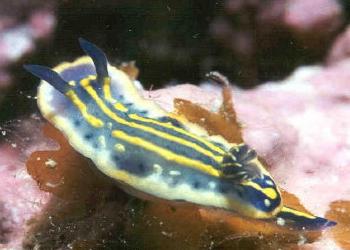
Dear Bill,
This one is from the Mediterranean Sea, France, Antibes, divesite "Cap d'Antibes", depth 20m, size 18mm, date May 28, 2000. It was taken by Jean-Pierre Bielecki [bielecki.jeanpierre@free.fr]
I wonder if it is a colour-variant of Hypselodoris picta or of Hypselodoris villafranca or something else.
Erwin
Medslugs.Koehler@t-online.de
Koehler, E., 2001 (Jan 26) Blue chromodorid from the Mediterranean. [Message in] Sea Slug Forum. Australian Museum, Sydney. Available from http://www.seaslugforum.net/find/3616Thanks Erwin,
Although these blue chromodorids are very fascinating they are also quite confusing. I suspect it is Hypselodoris picta (Schultz, 1836) but have asked Angel Valdes for his comments on its identity.
Best wishes,
Bill Rudman.
Re: Blue chromodorid from Antibes
January 26, 2001
From: Angel Valdes
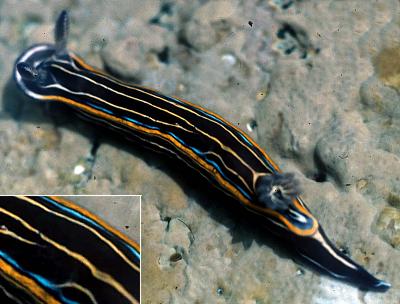
Dear Bill,
Please, find enclosed some comments on the photo in Erwin's message from Antibes, France you sent me, and a comparative photo [RIGHT] of H. villafranca.
The specimen from Antibes is a juvenile of Hypselodoris picta (Schultz in Philippi, 1836). There are several characteristics in this species that allow a positive identification. Hypselodoris picta is the only eastern Atlantic species of Hypselodoris, other than Hypselodoris villafranca, with more than two parallel yellow lines on the dorsum. Juvenile specimens have normally three lines, whereas in the adults the pattern is more complicated with numerous broken or entire lines. It is also characteristic of this species that two of the dorsal lines reach the rhinophoral sheaths. In adult specimens they form a yellow circle around the edge of the rhinophoral sheath and continue forward. In juvenile specimens, like this in the picture, the yellow circles are not formed yet. In addition, juvenile specimens have the mantle margin is surrounded by a white area. The dorsal yellow lines of both juveniles and adults reach the gill sheath but they never form a circle around it.
Hypselodoris villafranca (Risso, 1818) is another dark blue species with several dorsal yellow or white lines, but generally they form an irregular pattern, something like a broken network. In some small adults of H. villafranca, there may be three parallel lines too, but this species is easily distinguished from H. picta by the greyish coloration of the gill and rhinophores and the presence of a white line on the rhinophores (see photo enclosed). Also, in H. villafranca the dorsal yellow lines form a circle around the branchial sheath.
Other distinctive features of H. picta are the uniformly dark blue rhinophores, with no yellow or white pigment, and the branchial leaves with the external rachis yellow.
All the best,
Angel
avaldes@CalAcademy.org
Valdes, A., 2001 (Jan 26) Re: Blue chromodorid from Antibes. [Message in] Sea Slug Forum. Australian Museum, Sydney. Available from http://www.seaslugforum.net/find/3634Thanks Angel,
Bill Rudman
Greek goddess sea slug
July 19, 2000
From: Holly
I have recently purchased a hypselodoris endentica (Greek Goddess sea slug) and would like to know what it eats, if the pink slime string is eggs, or something else,and will it harm my reef tank(100 gal.), or hurt my fish, clowns, damsels. I have searched high and low on this pc, and if you don't know, could you please tell me what site could.
Thank-you.
Holly
officer@digitalusa.net
Holly, 2000 (Jul 19) Greek goddess sea slug. [Message in] Sea Slug Forum. Australian Museum, Sydney. Available from http://www.seaslugforum.net/find/2726Dear Holly,
It is really the wrong way around to buy a nudibranch and then check on how to keep it alive. More importantly, why are aquarium shops selling them and tricking customers into thinking they are herbivores, or easy to keep alive?
I am afraid Holly that your slug feeds on a few very particular species of sponge, which are themselves difficult to keep in aquaria, even in the unlikely event, that you could obtain some.
The 'pink slime' you mention is possibly their egg string. Have a look at the egg ribbon of a related sea slug Hypselodoris zebra.
The name you have for your sea slug, - hypselodoris endentica - has got a bit missing, it should be Hypselodoris endenticula, a species which is now considered part of a complex occurring on both sides of the tropical Atlantic and down to Brasil. The name we use for this species is Hypselodoris picta. Have a look at the pictures on that page to see some of the variety amongst Mediterranean examples. Also have a look at the page on Hypselodoris picta lajensis, a beautiful form from Brazil. I suspect your animal is quite similar, but from my reading, in your Caribbean form the yellow lines are broken into spots and there are yellow markings along the edge of the gills.
If you are able to photograph your sea slug it would be good to be able to add it to the variations we have on the website. It would also give your slug a chance of immortality - or at least a longer 'life' than it will have in captivity. Have a look at some of the other messages about keeping slugs in aquaria.
Will it hurt your fish? The short answer is no, although they may get a nasty taste in their mouth if they try and eat it. I don't know where you live, so I can't give you much idea on whether there is any point in trying to find a local sponge that your Hypselodoris will eat. On balance I guess there is nothing much you can do but keep it in your tank. It could last a couple of months without feeding. The alternatives, such as giving it back, throwing it in the sea etc, are probably not going to help the slug, so at least if you keep it you will be able to educate your friends about the dangers of buying unknown animals from aquarium shops.
Best wishes,
Bill Rudman.
Hypselodoris picta & Florida slug
June 1, 2000
From: Erwin Koehler

Dear Bill,
Concerning the recent message about a nudibranch from Florida, here are some photos of Hypselodoris picta. H. picta is the largest Nudibranch from the Mediterranean Sea and varies greatly in colour and pattern. In many publications the name Hypselodoris elegans (Cantraine, 1835) as Doris elegans is used. Ortea, Valdés and García-Gómez (1996) give their preference to Hypselodoris picta, because the name Doris elegans is occupied by Quoy & Gaimard, 1832. This publication is in Spanish - my Spanish is good enough to order drinks (una cerveza por favor), but not for real understanding this scientific text. There are 5 subspecies for H. picta defined, one of which is H. picta webbi.
PHOTOS:
•marco01: France, Antibes, divesite "Cap d'Antibes" size unrecorded, depth 14 m, July 1998, Photo by Armand di Marco, e-mail: armand.dimarco@ci.educ.lu
•ek075601: Italy, Elba Is., Capoliveri, divesite "Fonza" size 5 cm, depth 5 m , July 06, 1997.
•ek076703: Italy, Elba Is., Capoliveri, divesite "Stella" size 3 cm, depth 28 m , July 12, 1997.
•ek086520: Spain, Cala Joncols, divesite "El Bisbal" size 6 cm, depth 14 m , May 01, 1998.
•ek109227: Spain, Cala Joncols, divesite "La Virgen" size 45 mm, depth 13 m , April 27, 2000. [Photos "ek…" by Erwin Koehler]
Reference:
Ortea, J., Valdés, A. & and García-Gómez, J.C. (1996) Revisión de las especies atlánticas de la familia Chromodorididae (Mollusca: Nudibranchia) de grupo cromático azul. [Review of the Atlantic species of the family Chromodorididae (Mollusca: Nudibranchia) of the blue chromatic group.] Avicennia, 1996, Suppl. 1: 1-165.
Erwin
Medslugs.Koehler@t-online.de
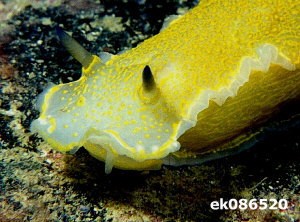

Dear Erwin,
Thanks for the great selection of photos of H. picta and for reminding me that H. webbi is considered now to be one of numerous synonyms of H. picta. I must say I was puzzled when I couldn't find any photos on the web through searching your online list but I was searching for 'Hypselodoris webbi' instead of just 'webbi' or 'Hypselodoris picta webbi'.
To all of you who are interested Erwin has a large selection of photos of the various colour forms of Hypselodoris picta on his Mediterranean Slug Site at http://www.medslugs.de/E/mssmain.htm and through his opisthobranch image list at http://www.medslugs.de/Opi/Opisthobranchia.htm.
Bill Rudman.
Florida nudibranch
May 26, 2000
From: Robert Schroff
HI!
I am trying to identify a nudibranch I observed in 45' feet of water on Saturday, May 13, 2000. The bottom type was coral / sand with lots of algae. The reef was an artificial reef site named M-16 approximately 10 miles off the west coast of Florida (Venice Inlet). The specimen was crawling slowly accross the bottom and was approximately 3" inches long. It had the usual snail-like head with a bell-like appendage protruding from the other end of the animal. The animal was black, with bright yellow markings. I was looking to identify this beautiful creature.
Any help would be greatly appreciated. Next time I will bring the camera.
Thank You,
Robert Schroff.
Robert_Schroff@hp.com
Schroff, R., 2000 (May 26) Florida nudibranch. [Message in] Sea Slug Forum. Australian Museum, Sydney. Available from http://www.seaslugforum.net/find/2446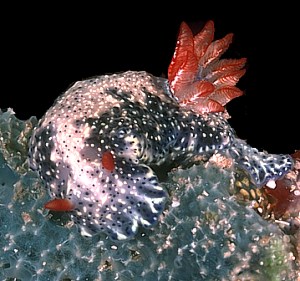
Dear Robert,
Although I would like to perform miracles, identifying nudibranchs from such a little bit of information is not that easy. Firstly,
is the cup-shaped object you mention like the red object on this photo of Hypselodoris saintvincentius? If so it is the circlet of gills.
I am not an expert on Caribbean molluscs and the only one that comes to mind from your description is Hypselodoris webbi (d'Orbigny, 1839) which in the Caribbean was previously known as H. edenticulata. It is described as bluish-black with yellow markings. Unfortunately I have no photo for you to compare and don't know of one elsewhere on the web. If someone would like to share one with us, especially from the Caribbean, I would be very grateful.
If it is this species, it is known from both sides of the Atlantic [Caribbean, Brazil, Canary Is, Atlantic ocast of France, Spain and Mediterranean coast of Spain and Greece].
I am sure we would be able to be of much greater help in future if you can send me a photo.
Best wishes,
Bill Rudman.
Reference: Gosliner, T.M (1990) Opisthobranch Mollusks from the Azores Islands. 1: Runcinidae and Chromodorididae. Azoreana, Supplement 135: 135-166.
Rudman, W.B., 2000 (May 26). Comment on Florida nudibranch by Robert Schroff. [Message in] Sea Slug Forum. Australian Museum, Sydney. Available from http://www.seaslugforum.net/find/2446